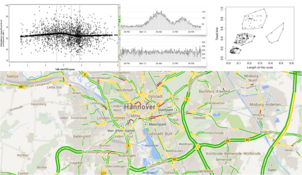
Multiagent-based Simulation of Co-operative Traffic Maneuvers

Due to the increasing individual mobility of traffic participants, rising resource consumption and a growing risk of accidents can be expected in the future [5]. Ongoing research in this field tries to reduce the risk of accidents by developing driver assisting technologies and infrastructure elements (C2X communication). The goal of these technologies is to raise the situation awareness of drivers and recommend optimized (tactical) maneuvers. Enabled by an underlying C2X infrastructure, cooperative maneuvers might help to improve the overall traffic flow and saturation of available road segments.
This raises the question whether cooperation between vehicles can have a positive effect on traffic efficiency (compared to non-cooperative case). Additionally we investigate whether cooperative driving maneuvers can have a positive effect on traffic safety and if these positive effects which can be observed (and the degree to) depends on penetration rate of vehicles capable of cooperative maneuvering.
As optimizing tactical maneuvers ranges from individuals and groups up to higher-level traffic management, it is sensible to combine these aspects in a joint architecture. Furthermore it is important for plans, agreed upon on a cooperating level, to be understood and executed on a local, driver level. Therefore a high-level abstraction and low-level refinement of plans is necessary.
The basic concept of a plan abstraction hierarchy was introduced by [3]. [1] combines these high-level task networks with action-based planning. [2] proposes an algorithm for finding optimal high-level plans in hierarchical plan structures. [4] provides a multiagent architecture to connect institutionalized traffic management with group-wise decision making and individual, anticipatory behavior.
In this thesis a three-layer approach will be proposed to tackle the questions raised above. Cooperative maneuvers will be managed in an architecture, similar to [4]. It will contain layers for institutionalised traffic management, abstract cooperative and norm-based maneuver planning and individual vehicle planning.
The focus will be on the micro and meso layers, designing an architecture to allow individual vehicles to execute joint maneuvers and provide an abstraction for distributing a hierarchical plan structure among them.
For an evaluation of the research questions, various scenarios will be investigated, each with different penetration rates of coordination aware vehicles. The results from a multiagent-based traffic simulation will be compared to answer the above questions.
[1] Kambhampati et al., Hybrid Planning for Partially Hierarchical Domains, AAAI-98
[2] Marthi et al., Angelic hierarchical planning: optimal and online algorithms, ICAPS-08
[3] Sacerdoti, Planning in a hierarchy of abstraction spaces, AIJ, 5(2), 115-135, 1974
[4] Sanderson, D.; Busquets, D.; Pitt, J., A Micro-Meso-Macro Approach to Intelligent Transportation Systems, Self-Adaptive and Self-Organizing Systems Workshops (SASOW), 2012 IEEE Sixth International Conference on , vol., no., pp.77,82, 10-14 Sept. 2012
[5] Stiller, C.; et al. DFG SPP 1835 Kooperativ interagierende Automobile
Researcher: Dipl.-Wirt.-Inf. Malte Aschermann
Student Research Projects
2014
Entwicklung eines Institutionellen Frameworks für Multi-Agentenbasierte Verkehrssimulation (Sabrina Wittek)
2015
Agent-based Simulation of Cooperative Driving Maneuvers of Autonomous Cars (Aditya Raj)